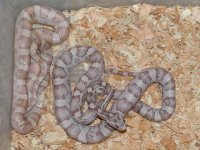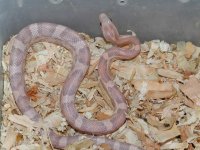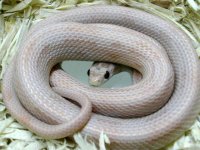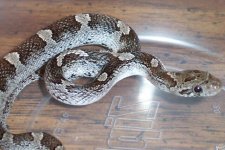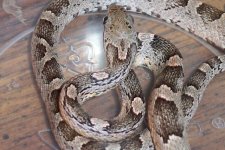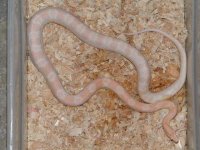ecreipeoj
Striped Topaz SK SG Free
A possible explanation
Usually, personal emails are strictly confidential between myself and the other party, but I do not think that Rich will mind in this case.
“Best I can speculate that I have had at least one new Hypo gene that has spontaneously cropped up into my stock.”
Rich Z.
Rich and I were discussing Hypo Lavenders, the confusion with them, and the likely hood that some Hypo Lavenders may not be compatible. Considering how our conversation was going at the time, when I read the above sentence I thought to myself, “Yeah, right!” No explanation was offered, no pictures, no nothing.
It is funny how things will come to mind sometimes. KAT and I were discussing hypos of course. We started off with Lavas and ended up giving our spiel for our name suggestions for Hypo Lav. She likes “Amethyst” and I like “Cotton Candy”. She sent me a picture of a sunset in her area and said that the adults remind her of a sunset at times. I sent her a picture of the “Sunset” Lav and said that this is what a sunset looks like around here everyday. Kat ask me if it was a Lav or Lava Lav and it just hit me that these guys could be mistaken for a Hypo Lav very easily and may in fact be a new type of hypo.
I have evidence in my Lavender Corn Snake colony that there may in fact be a hypo type gene contained within the lavender group that is unrelated to other hypos. My in house name for them for CAV, is “Lavender Hypo” (Homo Lav and ? or something new) instead of Hypo Lavender. (Homo hypo/lav). I called the first one I recognized “Lavender Hypo” The second one “What the hell is this” and “ Sunset” Lavender and the other one is also called a “Sunset” Lavender. I have also produced a “St. Lavender Hypo”.
All Lavenders like amels are distantly related as far as we know. Rich Z‘s and my Lavenders are distantly related. Most of my Lavenders came from Rainwater through Ted Frey, which is linked to Rich, is how the story goes I believe.
I would love to hear Rich’s explanation about how he suspects that a new hypo gene popped up in his lavender colony. He may highly suspect this, but doesn’t know exactly how he knows it. He has the Regular Hypo gene heavily bred into his lavender colony. Could he tell the difference between my “Sunset” Lavender Hypo and a Hypo Lavender?
I do not have the Regular hypo or any other type of known hypo in this group of my Lavender Corn Snakes, so I can isolate it. These “Sunset” type Lav hypos, all come from my St. Lavender Project group which is isolated from my other Lavenders. I used an Amel St. and a Rainwater Lavender to start the project. So far from this project, I have hatched out right at 300 viable offspring from them. No anerys of any kind, thank god, and no Hypo Lavenders. I have recognized four of these “Lav Hypo” type snakes. I have produced more St. Lav and St. Opals than these guys.
My initial theory was that I some how I isolated out the gene that lightens St. Corns. My new theory is that the new Hypo that Rich suspects popped up in his lavenders has also popped up in my lavenders, but since I do not have the Regular Hypo in the mix, I am able to recognize it for what it may be. I suspect that they are a new type of hypo from the lavender group that Rich has also suspected he has in his lavender colony.
These “Sunset” Lavenders are not Hypo Lavenders, but could they be mistaken for one?
Usually, personal emails are strictly confidential between myself and the other party, but I do not think that Rich will mind in this case.
“Best I can speculate that I have had at least one new Hypo gene that has spontaneously cropped up into my stock.”
Rich Z.
Rich and I were discussing Hypo Lavenders, the confusion with them, and the likely hood that some Hypo Lavenders may not be compatible. Considering how our conversation was going at the time, when I read the above sentence I thought to myself, “Yeah, right!” No explanation was offered, no pictures, no nothing.
It is funny how things will come to mind sometimes. KAT and I were discussing hypos of course. We started off with Lavas and ended up giving our spiel for our name suggestions for Hypo Lav. She likes “Amethyst” and I like “Cotton Candy”. She sent me a picture of a sunset in her area and said that the adults remind her of a sunset at times. I sent her a picture of the “Sunset” Lav and said that this is what a sunset looks like around here everyday. Kat ask me if it was a Lav or Lava Lav and it just hit me that these guys could be mistaken for a Hypo Lav very easily and may in fact be a new type of hypo.
I have evidence in my Lavender Corn Snake colony that there may in fact be a hypo type gene contained within the lavender group that is unrelated to other hypos. My in house name for them for CAV, is “Lavender Hypo” (Homo Lav and ? or something new) instead of Hypo Lavender. (Homo hypo/lav). I called the first one I recognized “Lavender Hypo” The second one “What the hell is this” and “ Sunset” Lavender and the other one is also called a “Sunset” Lavender. I have also produced a “St. Lavender Hypo”.
All Lavenders like amels are distantly related as far as we know. Rich Z‘s and my Lavenders are distantly related. Most of my Lavenders came from Rainwater through Ted Frey, which is linked to Rich, is how the story goes I believe.
I would love to hear Rich’s explanation about how he suspects that a new hypo gene popped up in his lavender colony. He may highly suspect this, but doesn’t know exactly how he knows it. He has the Regular Hypo gene heavily bred into his lavender colony. Could he tell the difference between my “Sunset” Lavender Hypo and a Hypo Lavender?
I do not have the Regular hypo or any other type of known hypo in this group of my Lavender Corn Snakes, so I can isolate it. These “Sunset” type Lav hypos, all come from my St. Lavender Project group which is isolated from my other Lavenders. I used an Amel St. and a Rainwater Lavender to start the project. So far from this project, I have hatched out right at 300 viable offspring from them. No anerys of any kind, thank god, and no Hypo Lavenders. I have recognized four of these “Lav Hypo” type snakes. I have produced more St. Lav and St. Opals than these guys.
My initial theory was that I some how I isolated out the gene that lightens St. Corns. My new theory is that the new Hypo that Rich suspects popped up in his lavenders has also popped up in my lavenders, but since I do not have the Regular Hypo in the mix, I am able to recognize it for what it may be. I suspect that they are a new type of hypo from the lavender group that Rich has also suspected he has in his lavender colony.
These “Sunset” Lavenders are not Hypo Lavenders, but could they be mistaken for one?

